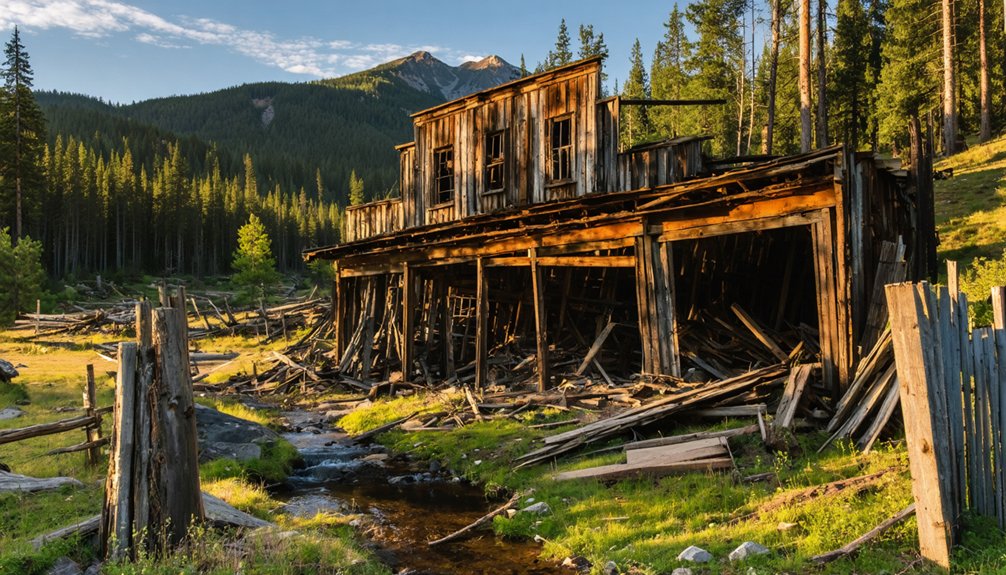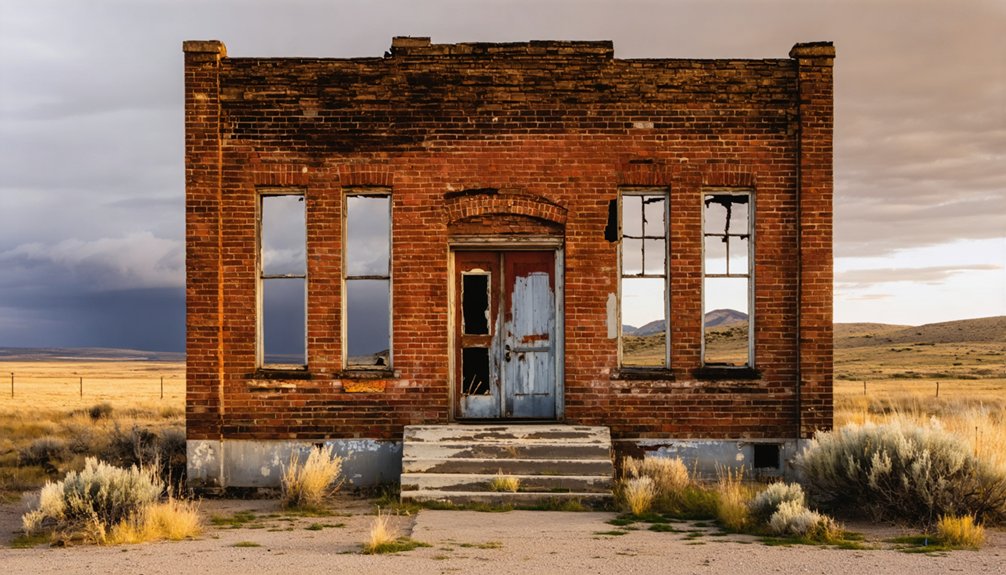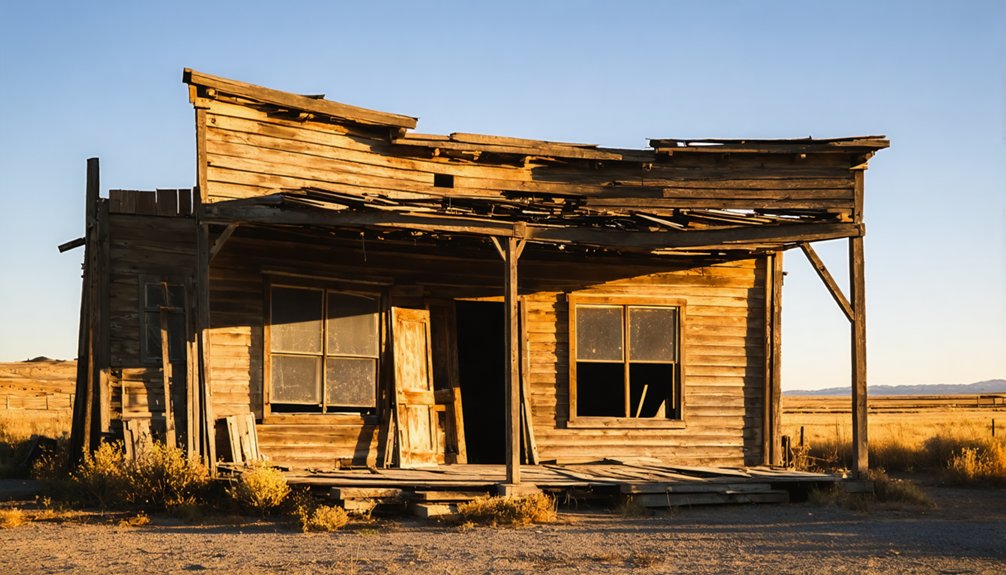You’ll find Moose City’s remains northeast of Pierce, Idaho, where gold was discovered on July 4, 1862. During its heyday, this bustling mining settlement drew thousands seeking fortune in the Clearwater River Basin’s creeks. Life centered around dawn-to-dusk mining, with evenings spent gambling at poker and faro tables. Today, only a Forest Service sign marks where this once-thriving boomtown stood, though its wild tales of frontier life, dangerous winters, and million-dollar strikes still echo through history.
Key Takeaways
- Moose City was established after gold discovery near Moose Creek in 1862, becoming a bustling mining settlement in Idaho’s Clearwater River Basin.
- The town thrived through gambling establishments, with poker and faro tables serving as social hubs for miners and travelers.
- Mining operations generated approximately $60 million in gold and silver before declining in the 1870s due to decreased profits.
- Harsh winters and isolation, being 200 miles from Lewiston, created severe challenges for miners and contributed to the town’s decline.
- Today, only a Forest Service sign marks where Moose City once stood, with nature reclaiming the former boomtown’s location.
The Gold Strike That Started It All
Discovery brought dramatic change to the remote Clearwater River Basin when wandering prospectors struck gold near Moose Creek and Independence Creek on July 4, 1862.
You’ll find this historic gold discovery several miles northeast of Pierce, Idaho, in the North Fork’s headwaters. The strike occurred during intense prospecting following earlier Clearwater finds, despite the area being part of the restricted Nez Perce Reservation.
The flourishing mining operations eventually attracted Chinese miners who took over many claims as white prospectors moved westward. As miners from California rushed in, they brought advanced mining techniques that would shape the region’s future. The discovery marked a turning point, becoming one of several major gold finds in the Clearwater drainage during 1861-1862.
Treaties soon opened these lands to prospectors, forever changing the landscape and leading to rapid development that would define Idaho’s early mining era. The area quickly evolved into a bustling settlement when essential services and stores were established to support the growing mining community.
Life in an 1860s Mining Boomtown
Chaos and opportunity defined life in the 1860s mining boomtowns, where Idaho City’s population swelled to over 7,000 residents, making it the largest settlement between San Francisco and Saint Louis.
Cultural diversity flourished as miners from California, Missouri, China, and Europe converged, creating a unique melting pot of traditions and experiences.
Your daily life in a mining town would revolve around:
- Dawn-to-dusk work in dangerous mining conditions
- Evening gatherings at saloons where whiskey flowed cheaper than water
- Weekend celebrations marked by gambling, fights, and community dances
Community dynamics centered on makeshift institutions and vigilante justice, as these frontier settlements lacked formal infrastructure. The high male ratio meant women were rare, with only one female resident for every nine men.
You’d find a largely male society where exhausted miners sought fortune in the day and relief in the town’s saloons and brothels by night.
The area’s incredible mineral wealth yielded over two billion in gold during the rush period.
Notable Characters and Their Stories
While Moose City’s individual characters remain largely lost to history, the surrounding Idaho mining region attracted numerous notable figures who shaped the area’s Wild West narrative.
You’ll find outlaw legends tied to nearby Silver City, where vigilante justice and gunfights regularly erupted in the streets between hired gunmen and mining factions. Even legendary lawman Wyatt Earp briefly called the region home in 1885, staying near Burke. The town’s mining claims generated approximately $60 million in gold and silver during its peak operations.
The area’s reputation for harboring fugitives persisted well into modern times, as evidenced by Boston mobster Enrico Ponzo, who hid in the Owyhee region for over a decade. Among the region’s renowned residents was Frank W. Burke, who gained prominence as a skilled mining executive in the early 1900s.
Burke’s mining operations drew their share of colorful characters too, becoming ground zero for labor leaders and corporate powers who clashed violently during the 1892 and 1899 mining wars.
The Rise and Fall of a Frontier Economy
After gold was discovered in the early 1860s along Moose Creek, a typical frontier economy sprang up to support the mining rush.
Like countless other Western boomtowns, Moose Creek’s gold discovery sparked an instant frontier economy catering to fortune-seeking miners.
You’d have found a bustling camp with essential services like saloons, hotels, and general stores meeting prospectors’ needs. The social dynamics reflected the town’s single-purpose nature, focused entirely on gold extraction. Many operations targeted gold, silver, and lead deposits throughout the region.
The Idaho State Society maintains historical records of such mining settlements. The economic challenges became evident as the boom cycle progressed:
- Mining profits decreased as easy-to-reach gold depleted
- Competing discoveries drew workers and investors away
- Lack of economic diversity left no backup industries
You can trace Moose City’s decline through its dwindling population and abandoned buildings.
As miners moved on to richer strikes, the town’s fate was sealed. The area eventually shifted to homesteading and timber industries, leaving Moose City to fade into Idaho’s ghost town history.
Gambling and Entertainment in the Wild West
Games of chance defined the social fabric of Moose City’s bustling entertainment scene. You’d find poker and faro tables crowded with cowboys, miners, and frontier legends testing their luck and wit.
The town’s gambling halls served as more than just gaming venues – they were social hubs where you could catch a show, grab a drink, or book a room for the night. As the town grew, simple tents evolved into ornate brick buildings that showcased the gambling halls’ success.
Professional gamblers and gunfighters, like Doc Holliday and Wyatt Earp, brought an air of excitement and security to these establishments. These gambling legends helped maintain order while running legitimate games. Bucking the tiger became a popular phrase for those brave enough to challenge the fast-paced Faro tables.
Among popular frontier pastimes, Spanish Monte attracted Texas cowboys, while Twenty-One drew diverse crowds. One misstep at the tables, though, and you’d risk more than your money – cheating often led to deadly consequences.
Daily Life Along Moose Creek
Along Moose Creek, you’d find prospectors from diverse backgrounds gathering in makeshift camps, sharing stories of their daily struggles and occasional gold strikes.
You’d witness the miners adapting to harsh conditions while maintaining a semblance of community life, complete with basic amenities and social activities centered around camps and trading posts.
Despite the remote location and challenging supply lines, you’d see how these determined individuals created their own entertainment, from card games to storytelling sessions, making life more bearable in this isolated mining settlement.
Mining Camp Social Scene
When Moose City sprang to life in the late 1860s, its social scene centered around a vibrant mix of essential establishments that served the camp’s 200 residents. Community dynamics revolved around the saloon, hotel, and general stores, where miners gathered after their shifts to unwind and socialize.
You’d find three distinct social hubs that shaped daily life:
- The saloon – the heart of gambling and drinking activities
- The hotel – a gathering spot for meals and lodging
- The general stores – where miners traded news while getting supplies
Social gatherings weren’t always harmonious, though. The camp’s diverse population, including Chinese and Hawaiian laborers, faced tensions and hardships.
While miners practiced rough egalitarianism among themselves, ethnic divisions influenced who could participate fully in the camp’s social life.
Prospectors’ Everyday Challenges
Life in Moose City tested even the hardiest prospectors, who faced brutal challenges in Idaho’s remote Bitter Root mountains.
You’d have battled harsh winters that claimed the lives of Kanaka and Chinese miners, while struggling with the isolation of being 200 miles from Lewiston. Your success depended on placer gold mining, but as deposits depleted and the economic decline of the 1870s hit, you’d have watched your prospects dwindle.
Daily life meant confronting rugged terrain along the North Clearwater River’s tributaries, with limited access to medical care or supplies. You’d have found basic amenities in the town’s saloon, restaurant, and hotel, but the psychological toll of isolation and brutal conditions would’ve worn you down.
Failed attempts at lode claims only added to your hardships.
Connections to Other Idaho Mining Towns
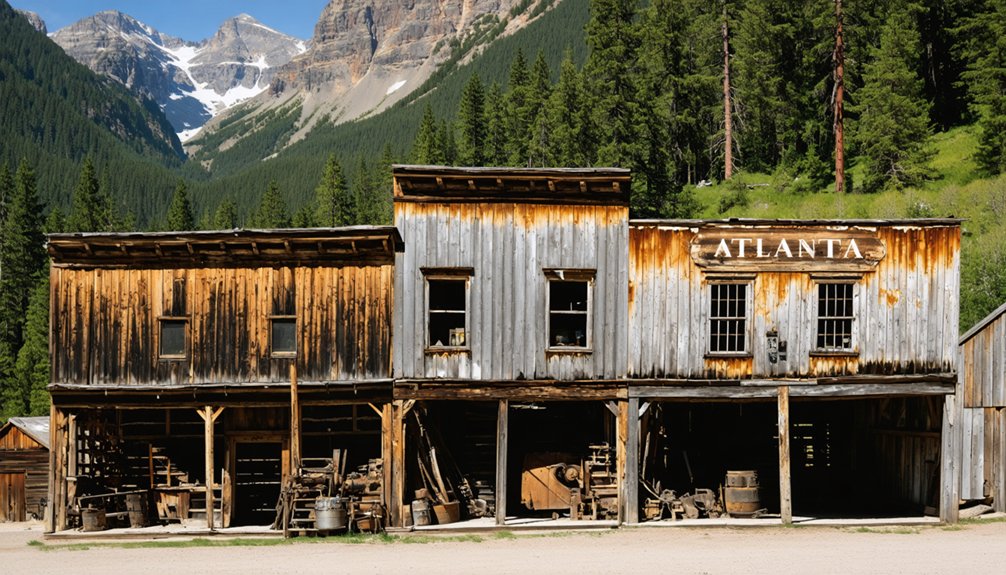
As gold discoveries spread throughout Idaho’s Clearwater Basin in the 1860s, Moose City emerged as part of an interconnected network of mining settlements that included Pierce City, Oro Fino, and Rhodes Creek.
Cross town migrations became common as prospectors chased promising strikes, while mining rivalries developed between settlements competing for resources and workers.
The Oro Fino Mining District unified these settlements under shared regulations, with three key developments shaping their interconnected destinies:
- The exclusion of Chinese miners until 1865
- Standardized claim rights and water usage rules
- District boundary adjustments as mining activity shifted
You’ll find these towns’ fates were deeply intertwined – when strikes dwindled in one location, populations would quickly shift to another.
This pattern continued until the 1870s, when most settlements faced sharp decline as easily accessible gold became scarce.
What Remains Today
Today at Moose City, you’ll find little evidence of its mining-era glory beyond a few level spots where buildings once stood.
The old jail, once a stark reminder of frontier justice, was dismantled by work camp crews, leaving no intact historical artifacts from the original settlement. Nature has steadily reclaimed the land, with young timber covering the ecological impact of the mining era.
While you can still try your luck panning for gold in the creeks as prospectors did generations ago, the town’s physical traces have largely vanished.
A solitary Forest Service sign marks the location where this bustling mining community once thrived. The surrounding forest has transformed the landscape into a peaceful wilderness, making it difficult to imagine the vibrant settlement that once occupied these grounds.
The Legacy of a Lost Settlement
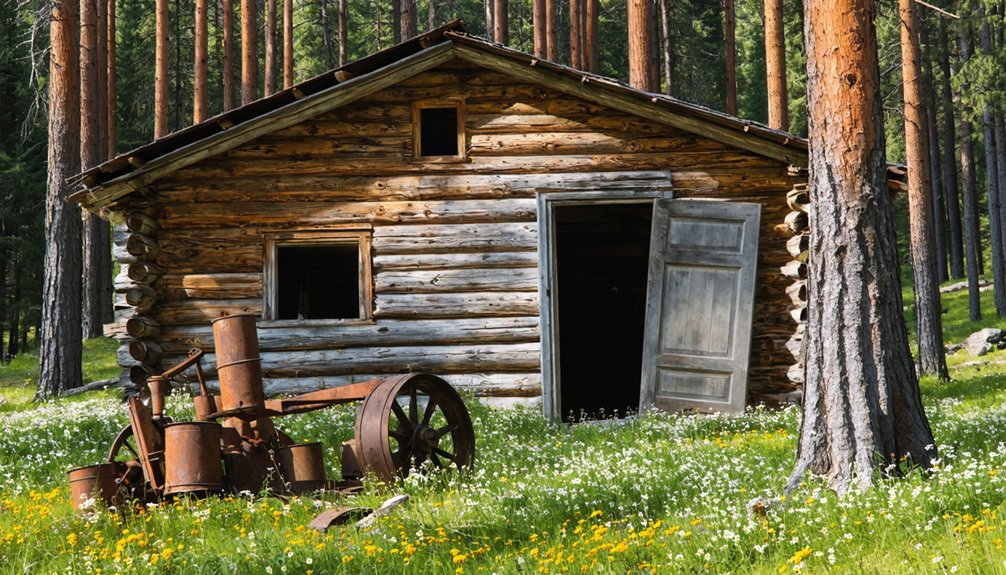
When you visit Moose City’s former site today, you’ll find little evidence of the bustling mining settlement that once yielded up to twenty-five dollars in gold per day for its fortune-seeking residents.
The town’s rapid rise and fall mirrors hundreds of other ghost towns across Idaho’s mining country, where prospectors chased their dreams from strike to strike in the 1860s.
Though the physical settlement has vanished, Moose City’s legacy lives on through its contributions to Idaho’s territorial development and the establishment of surrounding mining districts that shaped the region’s early economy.
Frontier Dreams Fade Away
The frontier dreams of Moose City vanished as swiftly as the gold that sparked its existence.
You’d have found a bustling scene of frontier aspirations in 1862, as prospectors rushed to Moose Creek’s promising claims. Transient communities formed around makeshift saloons and gambling halls, with characters like Mollie and her gold nugget necklace embodying the wild spirit of the era.
The town’s decline followed a familiar pattern:
- Surface gold deposits quickly depleted
- Miners moved on to richer strikes
- Support businesses couldn’t survive without steady income
You won’t find any traces of Moose City today – no buildings stand, no roads remain.
Like many Idaho boomtowns, it slipped into history, leaving only fragments of stories about frontier life and forgotten dreams of golden riches.
Mining Heritage Lives On
Although physical traces of Moose City have vanished into the forest, its mining heritage endures through preserved artifacts at the Clearwater Historical Museum and ongoing recreational prospecting along the creek beds.
You’ll find echoes of the past in the stories of diverse miners like William Rhodes, who struck it rich before moving on as the gold played out.
The town’s mining techniques and cultural influences shaped the broader Clearwater Basin’s development, shifting from gold extraction to timber harvesting and homesteading.
While the jail stood until 1924 as the last proof of frontier justice, today you’ll only discover level spots where buildings once stood.
Yet the spirit of freedom and opportunity that drew those first 200 settlers lives on through recreational prospectors who still pan these historic waters.
Tales From the Mining Frontier
During the initial gold rush of 1867-1868, prospectors Ernest Hilton, William Shepard, and Tommy O’Brien sparked a migration that brought 200 people to Moose City’s remote location in eastern Shoshone County.
The camp’s cultural exchanges became evident as white miners departed in the early 1870s, leaving Chinese and Kanaka miners to develop their own survival strategies in the harsh environment.
Life in the frontier proved unforgiving, as evidenced by these tragic events:
- Four Kanaka miners perished during one harsh winter
- An undocumented “horrible calamity” claimed several Chinese miners
- The jail, the last standing structure, disappeared by 1924
Despite these challenges, determined prospectors continued panning for decades, though the forest has now reclaimed most traces of this once-bustling mining settlement.
Frequently Asked Questions
What Was the Average Winter Temperature in Moose City During Its Peak?
Like a blanket of white silence, you’d face bitter temperatures averaging -5°C to -10°C (23°F to 14°F), with heavy average snowfall limiting winter activities to essential survival tasks.
How Did Miners Transport Their Gold Finds Out of Moose City?
You’d pack your gold out by horse or mule along mining routes to larger towns, using pack animals on rugged trails, and sometimes boats downstream when waterways permitted gold transport.
Were There Any Churches or Schools Established in Moose City?
You won’t find any church history or school establishment records in this gold-obsessed town. Despite neighboring camps having institutions, Moose City’s transient population focused on mining and entertainment rather than education or religion.
What Types of Food and Supplies Were Available to Residents?
You’d find basic canned goods, salted meats, and dried staples alongside essential mining supplies, though fresh food was scarce. Trading or bartering with other settlers helped expand your options.
Did Any Native American Tribes Live Near or Trade With Moose City?
You’ll find the Shoshone and Bannock tribes likely engaged in Native trade near the area, given their traditional presence in southern Idaho, though specific tribal influence on Moose City isn’t well documented.
References
- https://www.youtube.com/watch?v=hjQ9plwJeYg
- https://yellowpinetimes.wordpress.com/2023/04/09/idaho-history-apr-9-2023/
- https://clearwatercountyadventures.com/clearwater-county-history/
- https://history.idaho.gov/wp-content/uploads/2018/08/0064.pdf
- https://idaho-forged.com/idahos-ghost-towns-eerie-yet-approachable/
- https://dustywindshield.wordpress.com/2018/05/02/one-of-the-last-frontiers-of-the-west/
- https://www.ghosttowns.com/states/id/eagle.html
- https://en.wikipedia.org/wiki/List_of_ghost_towns_in_Idaho
- https://idahocityhistoricalfoundation.org/?page_id=147
- https://www.clearwatermuseum.org/our-history/mining.html
